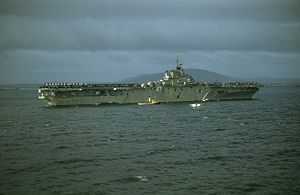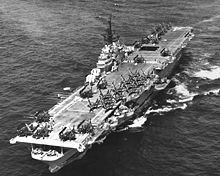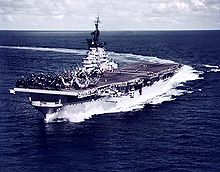- USS Philippine Sea (CV-47)
-
For other ships of the same name, see USS Philippine Sea.

USS Philippine Sea (CV-47) at Gibraltar in 1948Career (United States) 
Namesake: Battle of the Philippine Sea, 1944 Builder: Fore River Shipyard Laid down: 19 August 1944 Launched: 5 September 1945 Commissioned: 11 May 1946 Decommissioned: 28 December 1958 Struck: 1 December 1969 Honors and
awards:9 Battle Stars Fate: scrapped March 1971 General characteristics Class and type: Essex-class aircraft carrier Displacement: As built:
27,100 tons standardLength: As built:
888 feet (271 m) overallBeam: As built:
93 feet (28 m) waterlineDraft: As built:
28 feet 7 inches (8.71 m) lightPropulsion: As designed:
8 × boilers 565 psi (3,900 kPa) 850 °F (450 °C)
4 × Westinghouse geared steam turbines
4 × shafts
150,000 shp (110 MW)Speed: 33 knots (61 km/h) Complement: 3448 officers and enlisted Armament: As built:
4 × twin 5 inch (127 mm)/38 caliber guns
4 × single 5 inch (127 mm)/38 caliber guns
8 × quadruple Bofors 40 mm guns
46 × single Oerlikon 20 mm cannonsArmor: As built:
4 inch (100 mm) belt
2.5 inch (60 mm) hangar deck
1.5 inch (40 mm) protectice decks
1.5 inch (40 mm) conning towerAircraft carried: As built:
90–100 aircraftUSS Philippine Sea (CV/CVA/CVS-47, AVT-11) was one of 24 Essex-class aircraft carriers built during and shortly after World War II for the United States Navy. The ship was the first US Navy ship to bear the name, and was named for the 1944 Battle of the Philippine Sea. Philippine Sea was commissioned in May 1946, too late to serve in World War II. She spent her first few years operating mainly in the Atlantic, Caribbean, and Mediterranean, but also was deployed on special missions to the Arctic and Antarctic. She joined the Pacific Fleet in 1950, and served extensively in the Korean War, earning nine battle stars. In the early 1950s she was redesignated an attack carrier (CVA) and then an antisubmarine warfare carrier (CVS). She served the rest of her career in the Pacific.
Unlike many of her sisters, Philippine Sea received no major modernizations, and thus throughout her career retained the classic appearance of a World War II Essex-class ship. She was decommissioned in 1958, and while in reserve was redesignated an aircraft transport (AVT). She was sold for scrap in 1971.
Contents
Construction and Commissioning
Philippine Sea was one of the "long-hull" Essex-class ships. She was laid down by the Bethlehem Steel Company, Quincy, Massachusetts on 19 August 1944, and launched on 5 September 1945, sponsored by Mrs. Albert B. Chandler. Philippine Sea commissioned on 11 May 1946, with Captain Delbert Strother Cornwell in command.
Service history
In June, the ship went to Quonset Point, R.I. for initial training of the crew. By September 1946, she began her shakedown cruise in the Caribbean area with Air Group 20 embarked.
Upon returning from shakedown exercises, Philippine Sea was ordered back to Boston to prepare for the Navy's Antarctic Expedition, Operation Highjump. On 29 January 1947 in the Antarctic region of the South Pacific, Rear Admiral Richard E. Byrd and his party were flown from the ship to begin their polar explorations from Little America.
During the remainder of 1947, Philippine Sea operated in the Atlantic and Caribbean. In the spring of 1948, the ship was deployed to the Mediterranean to join Vice Admiral Forrest Sherman's 6th Fleet. With Air Group 9 on board, Philippine Sea showed the American ensign in France, Greece, Tunisia and Sicily. In June 1948, the huge carrier returned to the United States.
During the summer, Philippine Sea was engaged in developing doctrine for carrier control approach landings, the sea-going equivalent of GCA. November found her exploring the lower rim of the Arctic Circle in a cold weather operation designed to test planes, ships, and equipment.
In January 1949, the ship was again ordered to the Mediterranean, with Air Group 7 embarked. Returning at the end of May, the ship went immediately into overhaul at the Boston Naval Shipyard. Early autumn found the ship once more in the Caribbean, "shaking down," this time with Air Group 1. Operational development projects with jet fighters and task force exercises in the North Atlantic kept the ship and her air group busy until the end of the year.
Operating again from her base at Quonset Point, Philippine Sea was employed during the winter of 1950 in qualifying carrier pilots and, for part of February and most of March, took part in extensive fleet exercises in the Atlantic and Caribbean. April and May were taken up with demonstration cruises for guests of the Secretary of the Navy, the Armed Forces Industrial College, Air War College, and the Armed Forces Staff College.
On 24 May, Philippine Sea sailed from Norfolk, Virginia, passed through the Panama Canal, and arrived at her new homeport of San Diego, Calif., to become a welcome addition to the Pacific Fleet.
Korean War
With the outbreak of war in Korea, Philippine Sea was ordered to Pearl Harbor. She sailed for Hawaiian waters on 5 July with Air Group 11 embarked. The ship departed for the forward area on 24 July. Leaving Pearl Harbor, Philippine Sea sailed at full speed for the Western Pacific, reaching Okinawa on 4 August.
Philippine Sea sailed into action off Korea as flagship of Task Force 77 (TF 77) on 5 August. She launched air strikes to rain thousands of tons of bombs, rockets, and napalm down on strategic targets. As many as 140 sorties a day were launched from the carrier. Except for time out to re-arm, refuel, or repair for brief periods, Philippine Sea was in action continuously.
Operating with other carriers of TF 77, she hit North Korean rail and communication centers from Seoul to Wonsan in September. In the Yellow Sea she put on a major performance softening up the Incheon invasion coast. D-Day, 15 September, found Philippine Sea planes ranging far inland to destroy any attempts by the enemy to bring up reinforcements. Following the initial assault, she continued to provide close air support for the thrust inland to Seoul.
Two months later when the Chinese surprised the United Nations ground troops with an unexpected drive south, down the middle of the peninsula, Philippine Sea planes saw heavy action. Throughout the long retreat from the Yalu River, the ships' Panther jets, Skyraider attack bombers and Corsair fighter bombers provided air-cover for the trapped Marines. Hill after hill was cleared all the way to Hungnam where Philippine Sea and other carriers of TF 77 sent up a virtual aerial umbrella. Hundreds of carrier planes swarmed over the tiny evacuation perimeter from which 150,000 troops and civilians came to the sea.
Putting into Yokosuka Naval Base, Japan, in late March 1951 for rest and repair, Philippine Sea exchanged Air Group 11 for Air Group 2 from Valley Forge. The same date as the transfer on 28 March, Philippine Sea became flagship of Vice Admiral H. M. Martin, Commander 7th Fleet.
From the Sea of Japan in April, Philippine Sea led TF 77 and other elements of the 7th Fleet down through the Strait of Formosa to the South China Sea. From the Formosa Strait, planes paraded over the island of Formosa in an attempt to bolster Nationalist morale. After this demonstration of strength, the force steamed back to Korea three days later, in time to lend close air support to the embattled ground forces. Every Chinese offensive of the spring of 1951 suffered heavy losses in personnel as planes of Philippine Sea maintained air superiority.
Philippine Sea returned from her operations in Korean waters and the western Pacific to arrive at San Francisco on 9 June 1951. Yard availability and operations along the West Coast continued until the ship departed from San Diego on 31 December. Arriving at Pearl Harbor on 8 January 1952, Philippine Sea continued on to Yokosuka, Japan, arriving 20 January. Notable operations during this tour included an attack on the Sui-ho Dam and participation in a joint operation against Pyongyang.
Philippine Sea returned to San Diego in August 1952. Her designation was changed to CVA in October. With Carrier Air Group 9 embarked, she got underway once more for the Far East early in December 1952. Air strikes from the carrier cut enemy supply and transportation arteries. The North Korean offensive, begun at the same time the first truce overtures were extended, marked the beginning of a series of "round the clock" air sorties in support of frontline UN troops.
Post-Korea
The ship arrived in Alameda Naval Air Station on 14 August 1953 to off-load Air Group 9, then entered drydock at Hunters Point for overhaul. On 9 January 1954, Philippine Sea once more began training off the coast of San Diego. She then headed west on 12 March, for her fourth tour in the Far East. She operated out of Manila.
The most significant event of the cruise occurred in late July. Chinese planes had shot down a Cathay-Pacific Airways passenger liner near Hainan Island off the Chinese coast, believing it to be a Taiwanese military plane. Philippine Sea was ordered into the area as part of a search mission with the hope that the remaining survivors might be found. While engaged in the search mission, a flight of the ship's Skyraider aircraft was attacked by two enemy fighter aircraft. The Skyraiders returned the fire and shot down the planes. Later this came to be known unofficially as the "Hainan Incident".
The ship returned to San Diego, Calif., in November. Remaining in the area for four months, Philippine Sea conducted extensive training operations off the California coast. She began her fifth cruise of the Far East on 1 April 1955 en route to Yokosuka. She operated in waters of Japan, Okinawa, and Taiwan. On 15 November, she was redesignated as a CVS. She returned to San Diego on 23 November.
Leave, upkeep, and operations off the southern California coast and in Hawaiian waters followed and in March 1957, she got underway for another WestPac tour. There for only a little over two months, she returned to San Diego and resumed local operations off the west coast in mid-summer. In November 1957, she found the wreckage of Pan Am Flight 7, an around-the-world commercial airline flight that disappeared en route to Hawaii. In January 1958, she steamed west on her last 7th Fleet deployment. Remaining six months, she returned to San Diego on 15 July and commenced inactivation. Decommissioned 28 December 1958 and berthed with the Reserve Fleet at Long Beach, she was redesignated AVT-11 on 15 May 1959, and struck from the Navy Vessel Registry on 1 December 1969 and sold for scrapping on 23 March 1971 to Zidell Explorations Corp., Portland, Oregon. Ship's Bell located at SUPSHIPS, Bath, Maine.
Awards
Philippine Sea received nine battle stars for Korean War service.
See also
References
This article includes text from the public domain Dictionary of American Naval Fighting Ships.
Short-hull group Essex · Yorktown · Intrepid · Hornet · Franklin · Lexington · Bunker Hill · Wasp · Bennington · Bon Homme Richard
Long-hull group Ticonderoga · Randolph · Hancock · Boxer · Leyte · Kearsarge · Oriskany · Reprisal · Antietam · Princeton · Shangri-La · Lake Champlain · Tarawa · Valley Forge · Iwo Jima · Philippine Sea
Modernization Programs Preceded by: USS Wasp · Followed by: Midway class
List of aircraft carriers of the United States NavyCategories:- Essex class aircraft carriers
- Ships built in Massachusetts
- 1945 ships
- World War II aircraft carriers of the United States
- Cold War aircraft carriers of the United States
- Korean War aircraft carriers of the United States
Wikimedia Foundation. 2010.


